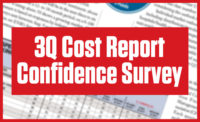Related Link:
ENR 2024 3Q Cost Report PDF
(Subscription Required)
ENR’s Construction Industry Confidence Index shows construction industry executive confidence virtually unchanged from last quarter, as many firms report they are waiting on the results of November’s general election. Just under half of CICI respondents mentioned the election results will impact their confidence levels in their provided comments. The CICI rose one point to a rating of 47 in Q3.
The confidence index measures executive sentiment about where the current market will be in the next three to six months and over a 12- to 18-month period, on a 0-100 scale. A rating above 50 shows a growing market. The measure is based on responses by U.S. executives of leading general contractors, subcontractors and design firms on ENR’s top lists to surveys sent between Aug. 5 and Sept. 16.
Confidence in the economy did fall 11.4% to a 39 rating this quarter. Last quarter 27.4% of CICI respondents saw a currently declining economy. This quarter that number is up to 37.8%. Firms are also significantly more pessimistic about the economy three-to-six months from now, with 40.5% seeing a declining economy in that range, up from 29.0% last quarter.
Design firms report much higher confidence than either GCs and CMs or subcontractors. Confidence among design firms rose slightly to 55 in Q3 from 54 in Q2. GC/CM confidence also rose, to 43 this quarter from a 37 rating last quarter. Subcontractors reported the largest swing as their rating dropped to 45 in Q3, from 51 in Q2. Subcontractor confidence has fallen 26.7% since Q1.

Source: ENR/BNP Media
Firms operating in the Midwest and Southeast report the highest confidence, with both regions coming in at a 52 rating. Most pessimistic are firms operating in the Rocky Mountain States, with a 40 rating.
Confidence in the distribution/warehouses sector fell 25.0% to a 36 rating this quarter. Only the retail (33) and commercial offices (22) sectors have a lower rating. Confidence remains highest in the power (76) and transportation (71) sectors.
Those results are largely matched by that of the Confindex survey from Princeton, N.J.-based Construction Financial Management Association (CFMA). Each quarter, CFMA polls CFOs from general and civil contractors and subcontractors on markets and business conditions. The resulting Confindex is based on four separate financial and market components, each rated on a scale of 1 to 200. A rating of 100 indicates a stable market; higher ratings indicate market growth.
Most indices the Confindex tracks saw negligible movement between Q2 and Q3. The overall Confindex rose just under 2% to a 108 rating. The “financial conditions” and “current conditions” indices both fell less than 2%, to ratings of 107 and 104 respectively.
The largest movement was seen in the “year ahead outlook” and “business conditions” indices, which rose to a 114 rating and a 110 rating, respectively.
The increase in the “year ahead outlook” in particular may be a sign CFOs believe they have largely weathered the storm, says Anirban Basu, CEO of Sage Policy Group and an advisor to CFMA. “I think CFOs are encouraged that their firms have managed to stay busy over a period during which monetary policy was actively tightening. [And] now they are looking forward to lower interest rates,” he says. On Sept. 18, the Federal Reserve voted to cut interest rates by 50 basis points, or .5%.
“If somebody told me a couple of years ago that the Federal Reserve is going to raise the upper limit on the Fed Funds rate from 0.25% to 5.5% and the construction industry would scarcely be impacted, I would say that’s nonsense,” Basu says.
The percentage of CFMA survey respondents reporting that they are very or highly concerned fell to 17% in Q3 from 31% last quarter. Of those firms, 64% are very or highly concerned about labor shortages. “That does not speak to an industry that’s about to enter some kind of recession, does it? [Firms] still need more workers to do the work that they do, and that suggests that they’re busy, and expect to remain busy,” says Basu.
The percentage of CICI survey respondents who reported their clients’ access to financing as “much tougher” than a year ago fell to 6.3% in Q3 from 14.5% in Q2.
Recession Still Incoming?
Basu still sees indications of dampening economic activity early next year. The Sahm rule, developed by economist Claudia Sahm, triggers when the three-month average U.S. unemployment rate rises by 0.5% or more from its 12-month low. That average just hit 0.57%. Applied to data back to the 1970s, it’s been coincident with every recession, explains Basu. “The notion is that if unemployment starts to rise too quickly, the labor market becomes disorderly, because layoffs produce layoffs,” he adds.
Basu also points to the inverted yield curve. “The two year Treasury interest rate has been above the 10 year treasury interest rate, but that just uninverted and often recessions begin right around the time that you get uninversion,” he says.





